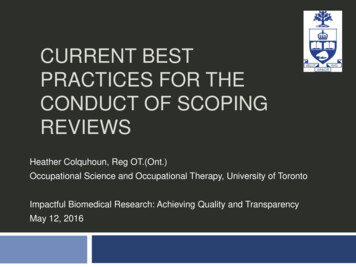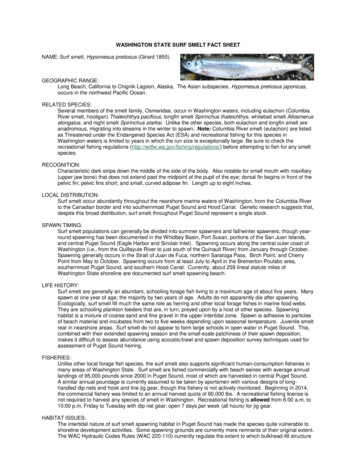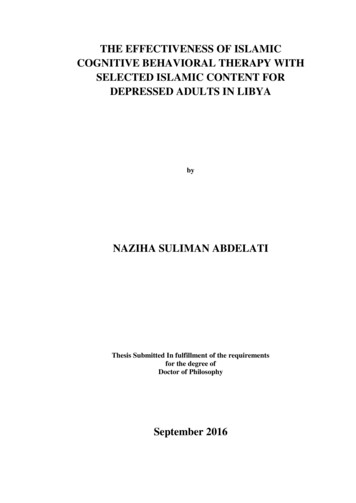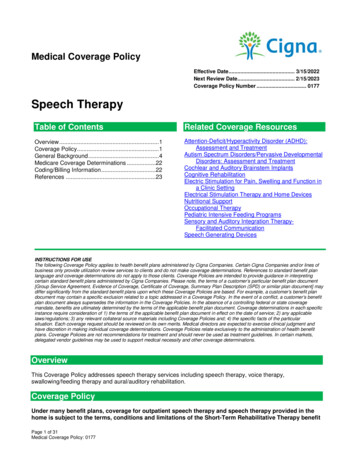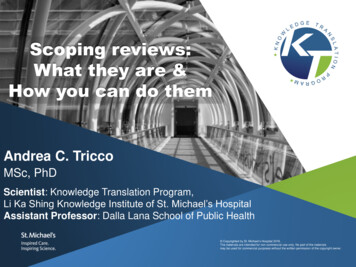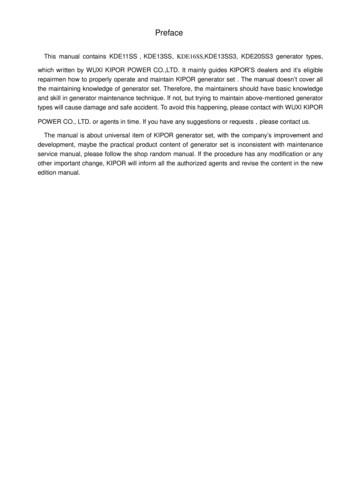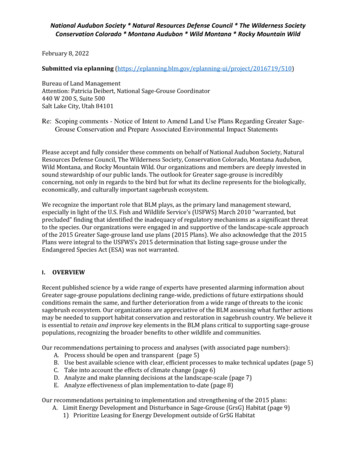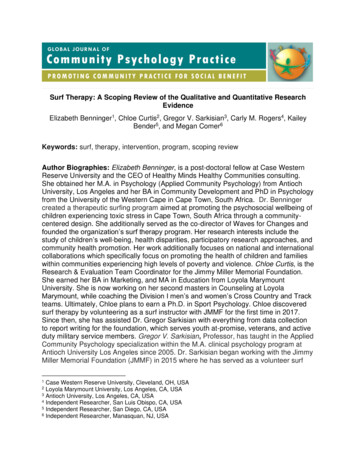
Transcription
Surf Therapy: A Scoping Review of the Qualitative and Quantitative ResearchEvidenceElizabeth Benninger1, Chloe Curtis2, Gregor V. Sarkisian3, Carly M. Rogers4, KaileyBender5, and Megan Comer6Keywords: surf, therapy, intervention, program, scoping reviewAuthor Biographies: Elizabeth Benninger, is a post-doctoral fellow at Case WesternReserve University and the CEO of Healthy Minds Healthy Communities consulting.She obtained her M.A. in Psychology (Applied Community Psychology) from AntiochUniversity, Los Angeles and her BA in Community Development and PhD in Psychologyfrom the University of the Western Cape in Cape Town, South Africa. Dr. Benningercreated a therapeutic surfing program aimed at promoting the psychosocial wellbeing ofchildren experiencing toxic stress in Cape Town, South Africa through a communitycentered design. She additionally served as the co-director of Waves for Changes andfounded the organization’s surf therapy program. Her research interests include thestudy of children’s well-being, health disparities, participatory research approaches, andcommunity health promotion. Her work additionally focuses on national and internationalcollaborations which specifically focus on promoting the health of children and familieswithin communities experiencing high levels of poverty and violence. Chloe Curtis, is theResearch & Evaluation Team Coordinator for the Jimmy Miller Memorial Foundation.She earned her BA in Marketing, and MA in Education from Loyola MarymountUniversity. She is now working on her second masters in Counseling at LoyolaMarymount, while coaching the Division I men’s and women’s Cross Country and Trackteams. Ultimately, Chloe plans to earn a Ph.D. in Sport Psychology. Chloe discoveredsurf therapy by volunteering as a surf instructor with JMMF for the first time in 2017.Since then, she has assisted Dr. Gregor Sarkisian with everything from data collectionto report writing for the foundation, which serves youth at-promise, veterans, and activeduty military service members. Gregor V. Sarkisian, Professor, has taught in the AppliedCommunity Psychology specialization within the M.A. clinical psychology program atAntioch University Los Angeles since 2005. Dr. Sarkisian began working with the JimmyMiller Memorial Foundation (JMMF) in 2015 where he has served as a volunteer surf1Case Western Reserve University, Cleveland, OH, USALoyola Marymount University, Los Angeles, CA, USA3 Antioch University, Los Angeles, CA, USA4 Independent Researcher, San Luis Obispo, CA, USA5 Independent Researcher, San Diego, CA, USA6 Independent Researcher, Manasquan, NJ, USA2
Global Journal of Community Psychology PracticeVolume 11, Issue 2April 2020instructor and more recently as the Director of Research and Evaluation for JMMF tobetter understand the benefits of surf therapy for youth at-promise and U.S. veterans.Since 2018, Dr. Sarkisian has been a member of the International Surf TherapyOrganization (ISTO) and he is actively engaged in coalition building, the disseminationof research on surf therapy and serves as a technical consultant to programs interestedin developing surf therapy program evaluations. Carly M. Rogers, is a clinicaloccupational therapist and independent researcher. She received her BA in Psychologyfrom the University of California at Santa Barbara and her masters and clinical doctoratein Occupational Therapy from the University of Southern California. During her master’scoursework, Dr. Rogers created a therapeutic surfing program titled Ocean Therapy,aimed at enhancing self-efficacy in participants from diverse backgrounds. She laterbecame the Director of Programs for the Jimmy Miller Memorial Foundation, where sheimplemented Ocean Therapy with underprivileged youth and military populations until2015. She has since presented at the regional, national and international level both onthe topics of surf therapy and occupational therapy’s role with veterans diagnosed withcombat PTSD. Dr. Rogers is the primary author of “High-Intensity Sports forPosttraumatic Stress Disorder and Depression: Feasibility Study of Ocean Therapy withVeterans of Operation Enduring Freedom and Operation Iraqi Freedom". Kailey Bender,is a pediatric occupational therapist. She received her BS in Kinesiology from CSU LongBeach, and her Masters of Science in Occupational Therapy from CSU DominguezHills. Kailey discovered surf therapy through the Jimmy Miller Memorial Foundation,where she volunteered as a surf instructor with veterans and at-risk youth. During herMaster's program, Kailey and her colleagues had the unique opportunity to research theeffects of ocean therapy on veterans with PTSD, and heard first-hand accounts of theprofound benefits it had upon their well-being. Since graduating, Kailey has volunteeredwith multiple other surfing therapy organizations throughout Southern California. MegComer, is an occupational therapist who specializes in pediatrics with children under theage of three. She additionally works in acute care and inpatient rehabilitation with adultsof all different needs and backgrounds. She received her MS in Occupational Therapyfrom Thomas Jefferson. She is additionally Aquatic Therapy and Rehabilitation InstituteCertified.Recommended Citation: Benninger, E., Curtis, C., Sarkisian, G. V., Rogers, C. M.,Bender, K., & Comer, M. (2020). Surf Therapy: A Scoping Review of the Qualitative andQuantitative Research Evidence. Global Journal of Community Psychology Practice,11(2), 1 – 26. Retrieved Day/Month/Year, from (http://www.gjcpp.org/).Global Journal of Community Psychology Practice, http://www.gjcpp.org/Page 2
Global Journal of Community Psychology PracticeVolume 11, Issue 2April 2020Surf Therapy: A Scoping Review of the Qualitative and Quantitative ResearchEvidenceAbstractOver the past 15 years, surf therapy has emerged as a growing therapeutic interventionin diverse communities around the world. Although the programs operate on thepremise that surf therapy provides a range of benefits for both physical andpsychological health, there is limited research evidence available to support these claims.There additionally remains a need to further develop evidence-based practices aroundsurf therapy that support the global impact of existing and future surf therapyinterventions. This research provides a scoping review of academic literature focused onsurf therapy. The objectives of the research are; (1) to gain a better understanding of theglobal use of surf therapy and its physical, psychological and social benefits, (2) toidentify intervention and research gaps related to surf therapy, (3) to providerecommendations for future surf therapy research, (4) to use the evidence to inform bestpractices in the field. A systematic article search of the meta-databases Google Scholar,EbscoHost, and Wiley yielded 18 studies that met the inclusion criteria. An additionalsearch for Master’s Theses, Doctoral Dissertations, and expert search yielded 11 studies.A total of 29 studies were found to meet criteria. The data from the studies were analyzedusing metasynthesis. As a result, the review provides an overview of the current scientificevidence related to surf therapy, including its physical, psychological, and social benefits.It additionally provides a detailed description of existing research methods andmeasures used to evaluate the impact of surfing as a therapeutic intervention that couldinform further research designs. The study supports surf therapy as a means ofimproving both physical and psychosocial health outcomes and includesrecommendations for improving surf therapy research and practice.Research EvidenceIn December 2019, surf therapy was definedby the International Surf TherapyOrganization (ISTO) as a method ofintervention that combines surfinstruction/surfing and structured individualand/or group activities to promotepsychological, physical and psychosocial wellbeing (International Surf TherapyOrganization, 2019). Surf therapyinterventions have been utilized acrossvarious disciplines including occupationaltherapy, physical therapy and psychology. Inthe clinical setting, mental and/or physicalhealth clinicians integrate their clinicalexpertise with the activity of surfing in orderto achieve therapeutic outcomes for theirclients. Other surf therapy interventions,however, are structured through a healthpromotion perspective. These programs mayor may not be run by clinicians and aim toimprove psychological, psychosocial and/orphysical health outcomes.Unlike traditional treatments that often use asymptom reduction approach through talktherapy and/or medication, surf therapyprograms utilize the physical activity ofsurfing as an anchor to the healing process. Inaddition to surf-instruction/surfing, theseprograms often include individual mentoring,social skills development, psychoeducationand/or group discussions to promote healing,strengths, resilience and personal growth inGlobal Journal of Community Psychology Practice, http://www.gjcpp.org/Page 3
Global Journal of Community Psychology PracticeVolume 11, Issue 2an inclusive social environment. Surf therapyis used as both a stand-alone intervention andas an augment to other approaches (e.g.,traditional psychotherapy and medicationmanagement).Although surf therapy programs emerged inthe 1990’s as non-profit organizations,research on surf therapy programs isrelatively new with the first peer-reviewedpublication appearing in 2010 (Morgan,2010). In the same year, a systematicliterature review of randomized control trialson sports for post-traumatic stress disorder(PTSD) concluded that none existed(Lawrence et al., 2010). More recently, theformation of the International Surf TherapyOrganization (ISTO) in 2017 has providedmore opportunities for surf therapy programpersonnel and researchers to collaborate andshare best practices and research strategies(ISTO, 2017). Globally, over 50 surf therapyprograms serve a wide range of populationsfrom youth with disabilities to veterans withPTSD. Although randomized control trialshave recently begun in some programs, manyprograms struggle with limited funding orresearch expertise to conduct surf therapyresearch. A number of studies have capturedthe physical, psychological, and socialbenefits of combining physical activity andbeing in nature, however, there is a furtherneed for evidence that supports thepotentially unique benefits of utilizing thesport of surfing as a key element of a noveltherapeutic intervention (Eigenschenk et al.,2019). The focus of this study was to gain anunderstanding of the current scientificevidence of surf therapy in order to informfurther research and practice in the field.Research Aims and ObjectivesThis research aims to provide a scopingreview of academic literature focused on surftherapy. The objectives of the research are;(1) to gain a better understanding of theglobal use of surf therapy and its physical,psychological and social benefits, (2) toApril 2020identify intervention and research gapsrelated to surf therapy, (3) to providerecommendations for future surf therapyresearch, (4) to use the evidence to informbest practice in the field.MethodsDue to the scarcity of empirical evidencerelated to surf therapy, along with thevariability in which surf therapy is defined,utilized, and measured, it was decided that ascoping review was an ideal methodology toidentify the current scope of evidence relatedto surf therapy and to clarify how surftherapy is utilized and defined acrossmultiple therapeutic sectors (Munn et al.,2018). The evidence presented in this scopingreview is intended to be a useful precursorfor defining more specific research questionsrelated to surf therapy and for conducting amore concentrated systematic review. Thisreview was conducted by a team of fiveresearchers and supervised by the leadauthor who is a trained research psychologistwith prior experience and training related toconducting systematic and scoping reviews.The review questions included: Whatinterventions exist related to surf therapy?What are the physical and psychologicalbenefits of these interventions? Who do theseinterventions serve? What research isavailable to support surf therapyinterventions? What are the gaps in research?And, how can this research inform bestpractices in the field?Included DatabasesEbscoHost, GoogleScholar, and Wiley metadatabases were searched for relevant studies.These metadatabases were selected due totheir inclusion of hundreds of relevant fulltext research articles and databases. Utilizingthese three meta-databases helped toguarantee adequate and efficient coverage ofrelevant research studies. Studies with titlesand abstracts that met the inclusion criteriawere obtained and reference lists of theGlobal Journal of Community Psychology Practice, http://www.gjcpp.org/Page 4
Global Journal of Community Psychology PracticeVolume 11, Issue 2identified studies scanned to identifyadditional relevant studies. Personal contactwas also made with research and practitionerexperts in the field of surf therapy whodirected the researchers to additionalrelevant studies.Time Period/Inclusion/ Exclusion Criteria(1) The time period considered was the last10 years (2008-2019) (2) The studyexamined or measured benefits related tosurf therapy (3) Study published in a peerreviewed journal, book or book chapter, orwas a Master's thesis or Doctoral Dissertationthat resulted in the award of a degree.Studies that did not meet criteria wereexcluded.Key WordsThe preliminary keywords used within thesearch were surfing, therapy, treatment,intervention, and program. During the initialsearch, the searches yielded over 100,000studies, with the majority of the studiesrelated to web surfing or interventions andtreatments other than those that included thesport of surfing. It was then decided tonarrow the search procedure to include thekeywords "surf therapy" OR "surfing" AND"treatment" OR "surfing" AND "therapy" andto limit the dates from 2008-2019. Althoughthe preliminary article searches andconsultations with experts in the fieldidentified the first surf therapy article to bepublished in 2010 (Morgan, 2010), it wasdecided to conduct a systematic search toinclude the last 10 years to ensure theinclusion of articles that may have beenmissed during the preliminary search.For the Google Scholar database, theresearchers were able to set it to include thestudies without the word internet in order toexclude the studies based on “surfing theinternet”. After the initial search stage ofpeer-reviewed academic journal articles, theresearchers decided that it would beApril 2020beneficial to conduct an additional search forMaster’s theses and Doctoral dissertations togain a more comprehensive understanding ofthe scope of research available on the topic.During this phase the research team reachedout to professionals in the field of surftherapy, searched the bibliographies of thestudies acquired through the initialsystematic search procedure, and additionallysearched CINAHL, OVID, and Google Scholarby using key search phrases including: "surftherapy" "surfing therapy", "masters theses","doctoral dissertations", "therapeuticsurfing", "surfing", "therapy" in combinationwith one another.Data ExtractionThe researchers independently extracted thedata from the studies identified, all of whichwere reviewed by a second researcher. Datawere extracted following the procedures ofmetasynthesis, a form of data analysiscommonly utilized within scoping andsystematic reviews that include bothquantitative and qualitative studies (seeBennion et al. 2012; Dolman et al. 2013; Wellset al. 2013) and formatted into a tablecommonly utilized for data extraction. Thetable was formatted to extract dataspecifically relevant to the research question,that included the study authors, aim, samplesize, population and subpopulation, types oftherapy/intervention, region, researchdesign, measures, length of intervention,outcomes, and themes.Data AnalysisData from the studies were analyzed usingthe procedures of metasynthesis. The analysisincluded a process of reading, rereading, andtaking notes of the key aims, methods, andfindings of each article (Bennion et al. 2012).This was followed by data extraction,characterized by the charting and thematiccoding of the data to provide a logical anddescriptive summary.Global Journal of Community Psychology Practice, http://www.gjcpp.org/Page 5
Global Journal of Community Psychology PracticeVolume 11, Issue 2ResultsThe article search procedure resulted in 29studies that met criteria. Ebscohost searchyielded a total of 63 hits, eight of which metcriteria through the abstract search andarticle review, an additional five studies metcriteria through reference mining.GoogleScholar yielded a total of 42 hits, sevenof which met criteria through the abstractsearch and article review, and an additional13 studies met criteria through referencemining. Wiley search yielded a total of 1,141hits, one of which met criteria through theabstract search and article review, and noadditional studies met criteria throughreference mining. Sixteen duplicates wereremoved from the three database searchesleaving a total of 18 studies. The search forMaster’s theses and Doctoral dissertationsyielded an additional five studies. An expertsearch, that included reaching out to aninternational network of surf therapyresearchers and practitioners, yielded 6additional studies that were not alreadyincluded in the systematic search procedure(See Figure 1).Figure 1. Article Search ProcedureSummary of FindingsThe Appedix includes the 29 referencesidentified through the scoping review. TableApril 20201 is located after the references and includescharacteristics of the studies included in thescoping review.Geographical region. Studies came from avariety of countries from various regions ofthe world, including Australia (Morgan,2010), New Zealand (Wheaton et al., 2017),Portugal (Matos et al., 2017; Lopes, 2015),South Africa (Rolfe, 2015; Snelling, 2015), theUnited Kingdom (Caddick, 2014; Caddick etal., 2015a; Caddick et al., 2015b; Colpus &Taylor, 2014; Godfrey et al., 2015; Hignett etal., 2018; Marshall et al., 2019), and theUnited States of America (Armitano et al.,2015; Cavanaugh & Rademacher, 2014;Clapham et al., 2014; Clapham et al., 2019;Crawford 2016; Fleischmann et al., 2011;Harris, 2015; Moore et al., 2018; Mueller,2017; Rogers, 2014; Rosenberg, 2014; Walteret al., 2019a; Walter et al., 2019b).Populations. The sample size ranged from 1to 492 participants. Most explored thepotential benefits of surf therapy for child andyouth participants (16). However, this wasclosely followed by a focus on various adultpopulations (13). Populations served includechildren and youth with a range ofdisabilities, children and youth with AutismSpectrum Disorder, children and youth inneed of social and emotional support, militaryservice veterans, active duty servicemembers, adults with various addictions andco-occurring psychological disorders, adultswith disabilities, and young adult cancersurvivors (See Table 1).Focus of therapy. All studies aimed to provideevidence of positive changes in well-beingthrough surfing. Focus areas includedphysical strength and fitness (6), generalhealth and well-being (4), psychological andmental health (9), and psychosocial wellbeing (13) with many programs aiming toimprove some combination of multiple areasfor a specific population (See Table 1). Mostprograms included supportive surfinstruction with some component of groupGlobal Journal of Community Psychology Practice, http://www.gjcpp.org/Page 6
Global Journal of Community Psychology PracticeVolume 11, Issue 2processing and/or mental health support. Theduration of programs ranged from one day tosix months in length, with most lastingbetween 5-8 weeks at one session per week.(See Table 1).Research design and measures. The mostcommonly utilized research designs wereobservational pretest-posttest (N 10) andcase study (N 9). Eleven studies usedstandardized measures, however there wassignificant variability in the measuresutilized, and inconsistency in the way thesame constructs (i.e. trauma, physical fitness)were measured across studies. Ten of thestudies included qualitative interviews. Otherqualitative data collection methods includedsemi-structured life history interview, focusgroup discussion, participant observation,field notes, and program data. There wereadditionally three literature reviews andthree program evaluations (See Table 1).Therapeutic Outcomes by PopulationChildren and youth in need of social andemotional support. Seven of the studiesfocused on surf therapy interventions withchildren and youth who were in need ofadditional social and emotional support. Theway this population was referred to variedbetween studies, however the majority of theprograms touched on the idea that for these“challenge averse” populations – foster youth,youth at-risk of isolation, youth with a historyof abuse and neglect, youth exposed toviolence– surf therapy provided amanageable challenge in a fun and supportivecontext. The results from these studiesincluded increases in self-concept, emotionalregulation and social competencies; reengagement with school, and decreases inbehavioral problems reported postintervention. However, the strength ofevidence related to these changes varied. Forexample, the studies by Snelling (2015) andMatos et al. (2017) used the strength anddifficulties questionnaire to measurebehavioral changes in participants ages nineApril 2020to sixteen. Although the results of Snelling(2015) showed no statistically significantchanges in behavior, Matos found significantimprovements in interpersonal relationshipsand emotional regulation. The absence ofsignificant findings in Snelling’s study couldbe due to a variety of factors that impactedprogram delivery, including inadequatecompletion of program tasks by coaches andincomplete attendance by participants, orfactors related to the research design, such asliteracy levels of the participants whocompleted the surveys (Snelling, 2015).Godfrey et al. (2015) used the StirlingChildren’s Well-being Scale, that measuressocial and psychological wellbeing with twosubscales: ‘positive outlook’ and ‘positiveaffect’; and reported statistically significantimprovements on both subscales as well asthe total. In qualitative interviews,participants also self-reported feeling better(96%), happier (98%), had fun (99%), madefriends (89%) and felt fitter (87%). Marshallet al. (2019) also used qualitative interviewsand found that participants reported feeling asense of mastery at learning a new skill,reported a feeling of respite and escape whileat the beach, and developed socialconnections with other peers whoparticipated in the program. These authorswere able to use these “consequentcategories,” defined as themes that arosefrom the research that affect the outcomes, inaddition to “antecedent categories,” thethemes that emerged from environmentalinputs that include social and physicalenvironmental factors as well as the surfingtherapy group design, to establish “corecategories” that attempt to explain how surftherapy works though program design. Theauthors determined that self-selected pacingand progression, as well as the creation ofboth an emotional and physical safe spacewithin the surf therapy group, contributed tothe success of the surf therapy groupparticipants.Global Journal of Community Psychology Practice, http://www.gjcpp.org/Page 7
Global Journal of Community Psychology PracticeVolume 11, Issue 2Colpus & Taylor (2014) measured changes inwell-being with an unstandardized scale, andtheir participants reported a mean increase inconfidence by 45.7%, with the mean scorerising approximately 2.5 points on a 10-pointscale (Taylor, 2013). Hignett, et al.’s (2018)study found a statistically significant increasein satisfaction with appearance, using arelevant portion of the British PanelHousehold Survey (BPHS-Y) formeasurement. The same study also reporteda significant decrease in resting heart rate,which indicates an increased level of aerobicfitness among participants (Hignett, et al.,2017).Youth with disabilities. For youth withdisabilities, results included improvements inphysical fitness, self-confidence, socialdevelopment, behavior and sleep, andreduced levels of anxiety. Children withdisabilities tend to have lower fitness levelsthan their able-bodied peers, as well as feweropportunities to participate in groupactivities – which only compounds theirdifficulties with confidence and socialinteraction (Moore et al. 2018; Mueller,2017). Armitano et al. (2015) used theBrockport Physical Fitness Test to measureupper body strength, core strength, andendurance pre and post intervention, withimprovements in all areas (Armitano et al,2015). Four of the studies focused on youthwith disabilities included qualitativeinterviews with the parents of participantswith various disabilities, all of which reportedincreases in confidence and social skills aswell as improvements in behavior (Armitanoet al., 2015; Clapham et al.; Moore et al., 2018;Mueller, 2017). Some parents described surftherapy as a “normalizing” opportunity fortheir children who are typically excludedfrom social events, and others noted that surftherapy provided a rare opportunity forfamily bonding (Moore et al., 2018). Thosestudies that focused specifically onpopulations with Autism Spectrum Disorderreported that the ocean served as a uniquetherapeutic environment with just enoughApril 2020sensory input for participants with ASD(Cavanaugh, 2014; Moore et al., 2018;Mueller, 2017). One parent of two childrenwith ASD who participated in an eight-weeksummer program described, “The tightness ofthe wetsuit is a good thing for both mychildren. They are both deep-pressureseekers. So, between the wetsuit, the crashingof the waves, just the water on the wetsuit,it’s all sensory” (Moore et al., 2017).Congruently, most parents reported the samesensory inputs to have a calming effect ontheir children with ASD, that seemed to leadto reduced anxiety and better sleep(Cavanaugh & Rademacher, 2014; Clapham etal, 2014.; Moore et al., 2018; Mueller, 2017).Active duty military service members. Foractive duty military service members, Walters(2019a) showed that following six weeks ofsurf therapy among 74 participants, negativeaffect and symptoms of depression, anxiety,and PTSD (among those with probable PTSD)significantly decreased and positive affectsignificantly improved; however, 75% ofparticipants were receiving some other typeof treatment (e.g., psychotherapy, medicationmanagement, physical therapy) in addition tosurf therapy. The study also looked at theimmediate effects of a surf session, measuredbefore and after each session, and foundsignificant improvements in depression,anxiety, and positive affect. In one case studyinvolving an active duty military servicemember, surfing was found to have the abilityto provide an alternative form of painmanagement (Fleischmann, 2011). Thesefindings, combined with the larger body ofevidence supporting the effects of surftherapy for military veterans and others, haveled to the development of the sector’s firstrandomized control trial (Walters, 2019b).The RCT will compare surf and hike therapyas complementary interventions for activeduty service members with major depressivedisorder, to understand whether changes indepressive symptoms over time varybetween the two interventions. Among otherfactors, it is hypothesized that surf therapyGlobal Journal of Community Psychology Practice, http://www.gjcpp.org/Page 8
Global Journal of Community Psychology PracticeVolume 11, Issue 2may have even greater benefits than otheroutdoor activities, because the interventionrequires participants to be immersed in thewater or ‘blue space’.Veterans. For veteran populations, surftherapy reportedly provided respite from thesymptoms of PTSD, in addition to decreasedstress levels, depressive symptoms and use ofnarcotics, and an increase in feelings of selfefficacy (Caddick, 2014; Caddick et al., 2015a;Caddick et al., 2015b; Crawford, 2016;Rogers et al., 2014). Furthermore, Rogers etal. (2014) found that surf therapy acted as ameans for veterans to improve feelings ofself-efficacy through success in goal-directedactivities. As a result, this increase in feelingsof self-efficacy may be linked to a statisticallysignificant reduction in depressive symptoms.A study by Caddick et al. (2015ab) discussedthe impact of surf therapy on providingrespite from depressive and PTSD symptoms.By engaging in surfing, veterans reportedfeeling a brief break from the symptoms ofPTSD, as surfing demands focusing on thepresent, providing periods of respite(Caddick, 2015ab). Through stringingtogether periods of surfing, veterans reportedfeeling better able to manage their symptomsof PTSD.Young adult cancer survivors. In a study byRosenberg (2014), a young adult populationof cancer survivors was investigated toexplore the impact surfing has on theparticipants’ body image, self-esteem, andself-compassion. Results included decreasesin self-reported depressivesymptoms/depression as well as decreasedfeelings of alienation (Rosenberg, 2014). Inaddition, participants reported increasedfeelings of positive body image, self-esteemand self-compassion following the conclusionof their engagement in surfing (Rosenberg,2014).Adults recovering from addiction. One studyfocused on an adult population recoveringfrom addiction (Harris, 2015). Results fromApril 2020this phenomenological study found five mainthemes including mindful embodiment,developing secure attachment, selfempowerment, differentiation, and surfing asa ritual and spiritual experience in relation tothe investigated healing phenomenon ofsurfing (Harris, 2015). Of particular emphasisis the relationship between mindfulembodiment and supporting the repair of themind-body
She earned her BA in Marketing, and MA in Education from Loyola Marymount University. She is now working on her second masters in Counseling at Loyola Marymount, while coaching the Division I men's and women's Cross Country and Track teams. Ultimately, Chloe plans to earn a Ph.D. in Sport Psychology. Chloe discovered
